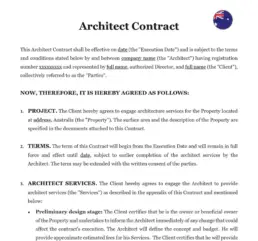Ready to use legal template
Drafted by experienced lawyers
Compliant with Australian law
Ready to use legal template
Drafted by lawyers
Compliant with Australian law
Home › Buy a property › Architect contract
Learn more about Architect Contract in Australia
An Architect Contract is a legally binding agreement between an architect and a client in Australia, outlining the terms and conditions of their professional relationship regarding architectural services. This contract typically includes details such as project scope, timelines, fees, responsibilities of both parties, and provisions for dispute resolution. It serves to formalize the arrangement between the architect and client, ensuring clarity and protection for all involved throughout the architectural project.Our easy-to-edit templates streamline the document preparation process, ensuring that you have professionally crafted documents at your fingertips, ready to be customized to your unique needs.
Table of contents
What is an Architect Contract in Australia?
What is included in the Architect Contracts?
How do Architect Contracts address intellectual property rights related to architectural designs?
What are the typical payment structures outlined in Australia?
Are there specific regulations requirements that architects must adhere to?
What provisions should be included in Architect Contracts to address changes?
How do Architect Contracts in Australia handle issues such as delays?
What steps should clients take to ensure that the Contract reflects their project requirements?
Are there any industry-standard terms included in Architect Contracts to protect both parties' interests?
What is an Architect Contract in Australia?
An Architect Contract in Australia is a legally binding agreement between an architect and a client that outlines the terms and conditions of their professional relationship regarding architectural services. These contracts govern the provision of architectural services, including design, planning, documentation, and project management, for various construction projects.
Architect Contracts serve to formalize the relationship between the architect and the client, providing clarity on the scope of work, responsibilities, timelines, fees, and other essential aspects of the architectural services to be provided. These contracts help protect the interests of both parties by clearly defining their rights, obligations, and expectations throughout the project.
Architect Contracts in Australia may be tailored to suit the specific needs and requirements of different projects, taking into account factors such as project size, complexity, duration, and budget. These contracts are typically prepared and reviewed by legal professionals to ensure compliance with relevant laws and regulations governing architectural services.
What is included in the Architect Contracts?
Architect Contracts in Australia typically include a comprehensive set of provisions covering various aspects of the architectural services to be provided. Some common elements included in Architect Contracts are:
1. Scope of Work:
A detailed description of the architectural services to be performed by the architect, including design, documentation, specifications, project management, and any other related tasks.
2. Project Timeline:
The agreed-upon schedule for completing the architectural work, including key milestones, deliverables, and deadlines.
3. Fee Structure:
The architect’s compensation for their services, including the basis for fees (e.g., hourly rates, fixed fee, percentage of construction cost), payment schedule, and any additional expenses or disbursements
4. Responsibilities of Parties:
The roles and responsibilities of both the architect and the client throughout the project, including communication protocols, decision-making processes, and collaboration requirements.
5. Intellectual Property Rights:
Provisions regarding ownership and use of intellectual property, including copyright, design rights, and licenses for architectural drawings and documents.
6. Insurance and Liability:
Requirements for professional indemnity insurance coverage, liability limitations, and procedures for handling claims or disputes arising from the architectural services.
7. Termination and Dispute Resolution:
Procedures for terminating the contract, resolving disputes, and handling breaches of contract by either party.
These are just some of the key components typically included in Architect Contracts in Australia. The specific terms and conditions may vary depending on the nature of the project, the preferences of the parties involved, and any applicable legal requirements or industry standards.
How do Architect Contracts in Australia address intellectual property rights related to architectural designs?
Architect Contracts in Australia typically address intellectual property rights related to architectural designs by outlining ownership, licensing, and permitted uses of design documents and intellectual property. These contracts commonly specify that the architect retains copyright ownership of their original designs, including drawings, plans, specifications, and other design documents. However, they may grant the client a non-exclusive license to use the designs for the specific project outlined in the contract. Any additional or broader use of the designs, such as replication, modification, or distribution, may require the architect’s express consent or negotiation of additional licensing terms. Additionally, provisions regarding confidentiality, non-disclosure, and non-compete obligations may be included to protect the architect’s proprietary information and prevent unauthorized use or disclosure of their designs.
What are the typical payment structures outlined in Architect Contracts in Australia?
Payment structures outlined in Architect Contracts in Australia vary depending on the scope and complexity of the architectural services provided. Common payment arrangements include lump-sum fees, percentage-based fees (e.g., percentage of total project cost), hourly rates, or a combination of these methods. The contract specifies the timing and milestones for payment, such as upfront deposits, progress payments based on completed design stages or project phases, and final payment upon project completion or deliverables acceptance.
Retainers or holdbacks may also be included to ensure payment security or incentivize timely performance. Additionally, provisions for reimbursable expenses, such as travel, printing, or consultant fees, may be detailed in the contract, along with procedures for invoicing, payment certification, and dispute resolution related to payment issues.
Are there specific regulations or licensing requirements that architects must adhere to?
Architects entering into contracts in Australia must comply with specific regulations and licensing requirements to legally practice architecture. These requirements typically include registration with the relevant state or territory architectural registration board or authority, which sets minimum education, experience, and professional competency standards for architects. Architects must hold a valid practicing certificate or license to offer architectural services and use the title “architect” in connection with their practice. Compliance with professional codes of conduct, ethics, and standards of practice is also essential to maintain licensure and uphold professional integrity. Clients should verify the architect’s credentials, qualifications, and registration status before entering into a contract to ensure they are engaging a licensed and reputable professional who meets regulatory requirements.
What provisions should be included in Architect Contracts to address changes?
Architect Contracts in Australia should include provisions to address changes or modifications to the project scope, known as variations or amendments.
These provisions outline procedures for documenting, assessing, and implementing changes to the architectural design or services requested by the client or project stakeholders.
The contract typically requires the client to submit variation requests detailing the proposed changes, including the reasons for the modification, any associated cost or schedule impacts, and the desired outcomes. The architect evaluates the variation request, provides recommendations or alternatives, and seeks the client’s approval before proceeding with the changes.
Clear documentation, including revised drawings, specifications, and cost estimates, is essential to formalize variations and ensure transparency and accountability throughout the change management process.
🔗 If you are only planning renovation or interior design work, you can download the Interior Design Contract instead of the Architect Contract, which is suitable for larger works.
How do Architect Contracts in Australia handle issues such as delays or unforeseen circumstances?
Architect Contracts in Australia address issues such as delays or unforeseen circumstances during the project through provisions outlining responsibilities, liabilities, and dispute resolution mechanisms. These contracts typically allocate risks and responsibilities between the parties for delays caused by factors beyond their control, such as weather, site conditions, or third-party actions.
The architect may include provisions for extensions of time to compensate for delays attributable to the client, contractor, or other project participants. Dispute resolution procedures, such as negotiation, mediation, or arbitration, may be specified to resolve disputes arising from delays or unforeseen circumstances promptly and amicably. Clients should communicate any anticipated delays or changes to project timelines promptly to the architect to minimize disruptions and ensure timely resolution of issues.
🔗 In order to define the broad outlines of the construction that will be carried out by a builder, you can also download the Construction Contract which describes, in detail, the parameters of a construction project in Malaysia.
What steps should clients take to ensure that the Architect Contract reflects their project requirements?
Clients should take proactive steps to ensure that Architect Contracts accurately reflect their project requirements, expectations, and objectives in Australia. This involves thorough project planning, scoping, and communication with the architect to articulate project goals, functional requirements, design preferences, and performance criteria upfront. Clients should provide comprehensive project briefs, including site information, budget constraints, sustainability goals, and desired project outcomes, to guide the architect’s design development process. During contract negotiation, clients should review and discuss contract terms, deliverables, timelines, and payment arrangements with the architect to ensure alignment with their expectations and priorities. Engaging legal or construction professionals to review and advise on contract terms can provide additional assurance and protect the client’s interests throughout the project lifecycle.
Are there any industry-standard terms included in Architect Contracts to protect both parties' interests?
Architect Contracts in Australia commonly include industry-standard terms and clauses to protect both parties’ interests and clarify rights and obligations. These standard provisions may cover a range of topics, including scope of services, project deliverables, fees and payment terms, insurance requirements, intellectual property rights, liability limitations, termination rights, and dispute resolution procedures. Clients and architects should carefully review and negotiate contract terms to ensure they reflect the specific requirements and priorities of the project while complying with applicable legal and regulatory requirements. While some standard terms may be customary within the architecture industry, parties should seek legal advice to understand their implications and ensure they align with their respective interests and risk tolerance levels.
Share information
Why Themis Partner ?
Make documents forhundreds of purposes
Hundreds of documents
Instant access to our entire library of documents for Australia.
24/7 legal support
Free legal advice from our network of qualified lawyers.
Easily customized
Editable Word documents, unlimited revisions and copies.
Legal and Reliable
Documents written by lawyers that you can use with confidence.




